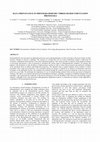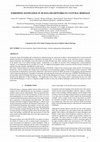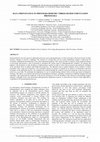Papers by Marleen de Kramer

At present, where 3D modeling and visualisation in cultural heritage are concerned, an object's d... more At present, where 3D modeling and visualisation in cultural heritage are concerned, an object's documentation lacks its interconnected memory provided by multidisciplinary examination and linked data. As the layers of paint, wood, and brick recount a structure's physical properties, the intangible, such as the forms of worship through song, dance, burning incense, and oral traditions, contributes to the greater story of its cultural heritage import. Furthermore, as an object or structure evolves through time, external political, religious, or environmental forces can affect it as well. As tangible and intangible entities associated with the structure transform, its narrative becomes dynamic and difficult to easily record. The Initial Training Network for Digital Cultural Heritage (ITN-DCH), a Marie Curie Actions project under the EU 7th Framework Programme, seeks to challenge this complexity by developing a novel methodology capable of offering such a holistic framework. With the integration of digitisation, conservation, linked data, and retrieval systems for DCH, the nature of investigation and dissemination will be augmented significantly. Examples of utilisating and evaluating this framework will range from a UNESCO World Heritage site, the Byzantine church of Panagia Forviotissa Asinou in the Troodos Mountains of Cyprus, to various religious icons and a monument located at the Monastery of Saint Neophytos. The application of this effort to the Asinou church, representing the first case study of the ITN-DCH project, is used as a template example in order to assess the technical challenges involved in the creation of such a framework.

Documenting the relevant aspects in digitisation processes such as photogrammetry in order to pro... more Documenting the relevant aspects in digitisation processes such as photogrammetry in order to provide a robust provenance for their products continues to present a challenge. The creation of a product that can be re-used scientifically requires a framework for consistent, standardised documentation of the entire digitisation pipeline. This article provides an analysis of the problems inherent to such goals and presents a series of protocols to document the various steps of a photogrammetric workflow. We propose this pipeline, with descriptors to track all phases of digital product creation in order to assure data provenance and enable the validation of the operations from an analytic and production perspective. The approach aims to support adopters of the workflow to define procedures with a long term perspective. The conceptual schema we present is founded on an analysis of information and actor exchanges in the digitisation process. The metadata were defined through the synthesis of previous proposals in this area and were tested on a case study. We performed the digitisation of a set of cultural heritage artefacts from an Iron Age burial in Ilmendorf, Germany. The objects were captured and processed using different techniques, including a comparison of different imaging tools and algorithms. This augmented the complexity of the process allowing us to test the flexibility of the schema for documenting complex scenarios. Although we have only presented a photogrammetry digitisation scenario, we claim that our schema is easily applicable to a multitude of 3D documentation processes.

At present, where 3D modeling and visualisation in cultural heritage are concerned, an object's d... more At present, where 3D modeling and visualisation in cultural heritage are concerned, an object's documentation lacks its interconnected memory provided by multidisciplinary examination and linked data. As the layers of paint, wood, and brick recount a structure's physical properties, the intangible, such as the forms of worship through song, dance, burning incense, and oral traditions, contributes to the greater story of its cultural heritage import. Furthermore, as an object or structure evolves through time, external political, religious, or environmental forces can affect it as well. As tangible and intangible entities associated with the structure transform, its narrative becomes dynamic and difficult to easily record. The Initial Training Network for Digital Cultural Heritage (ITN-DCH), a Marie Curie Actions project under the EU 7th Framework Programme, seeks to challenge this complexity by developing a novel methodology capable of offering such a holistic framework. With the integration of digitisation, conservation, linked data, and retrieval systems for DCH, the nature of investigation and dissemination will be augmented significantly. Examples of utilisating and evaluating this framework will range from a UNESCO World Heritage site, the Byzantine church of Panagia Forviotissa Asinou in the Troodos Mountains of Cyprus, to various religious icons and a monument located at the Monastery of Saint Neophytos. The application of this effort to the Asinou church, representing the first case study of the ITN-DCH project, is used as a template example in order to assess the technical challenges involved in the creation of such a framework.

Documenting the relevant aspects in digitisation processes such as photogrammetry in order to pro... more Documenting the relevant aspects in digitisation processes such as photogrammetry in order to provide a robust provenance for their products continues to present a challenge. The creation of a product that can be re-used scientifically requires a framework for consistent, standardised documentation of the entire digitisation pipeline. This article provides an analysis of the problems inherent to such goals and presents a series of protocols to document the various steps of a photogrammetric workflow. We propose this pipeline, with descriptors to track all phases of digital product creation in order to assure data provenance and enable the validation of the operations from an analytic and production perspective. The approach aims to support adopters of the workflow to define procedures with a long term perspective. The conceptual schema we present is founded on an analysis of information and actor exchanges in the digitisation process. The metadata were defined through the synthesis of previous proposals in this area and were tested on a case study. We performed the digitisation of a set of cultural heritage artefacts from an Iron Age burial in Ilmendorf, Germany. The objects were captured and processed using different techniques, including a comparison of different imaging tools and algorithms. This augmented the complexity of the process allowing us to test the flexibility of the schema for documenting complex scenarios. Although we have only presented a photogrammetry digitisation scenario, we claim that our schema is easily applicable to a multitude of 3D documentation processes.
Thesis Chapters by Marleen de Kramer
Bachelor's Thesis in Architectural History and Theory [German]
Image 12 (below) -Th e map lines projected onto a topographical map with the height exaggerated b... more Image 12 (below) -Th e map lines projected onto a topographical map with the height exaggerated by a factor of fi ve to show the structure.








Uploads
Papers by Marleen de Kramer
Thesis Chapters by Marleen de Kramer